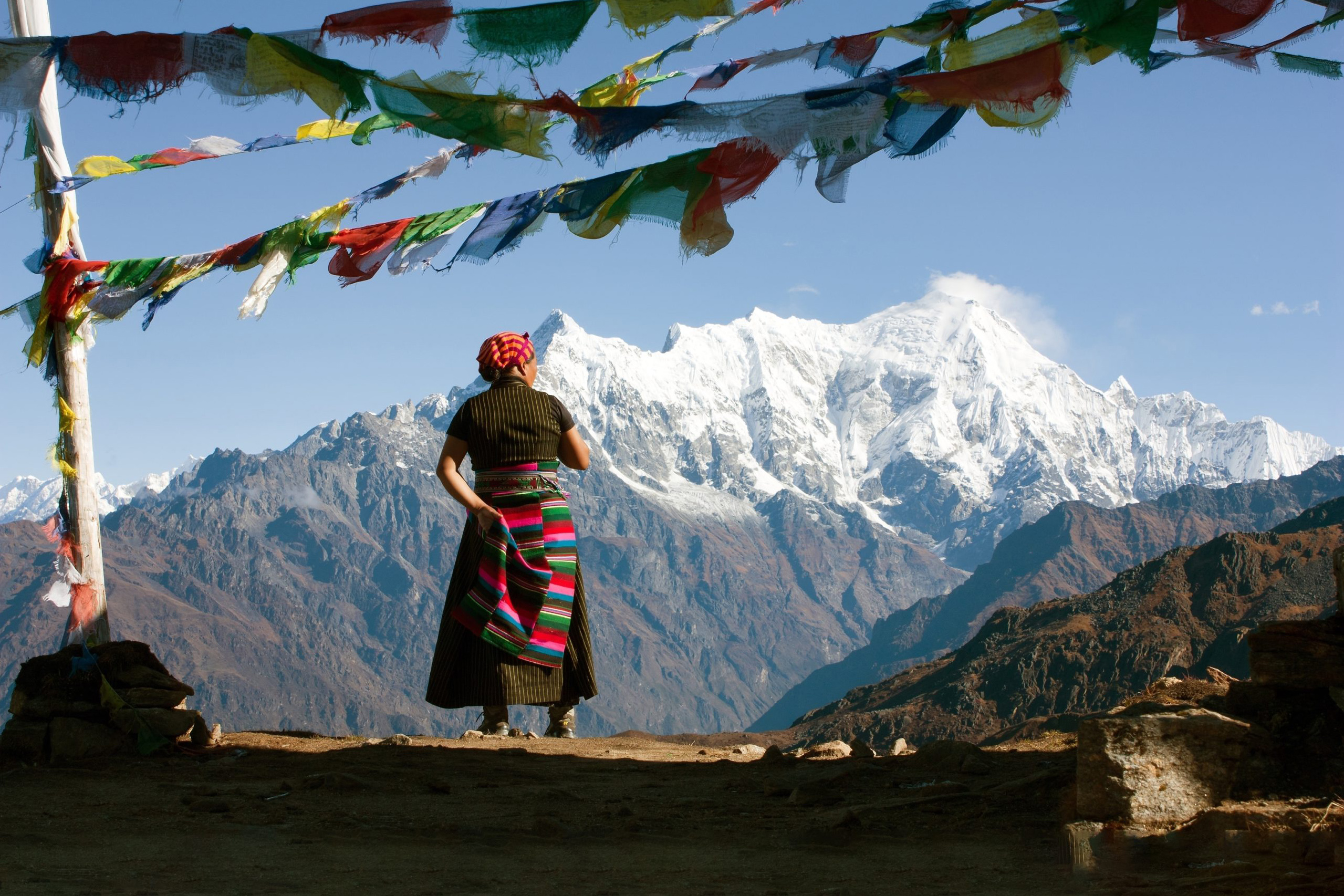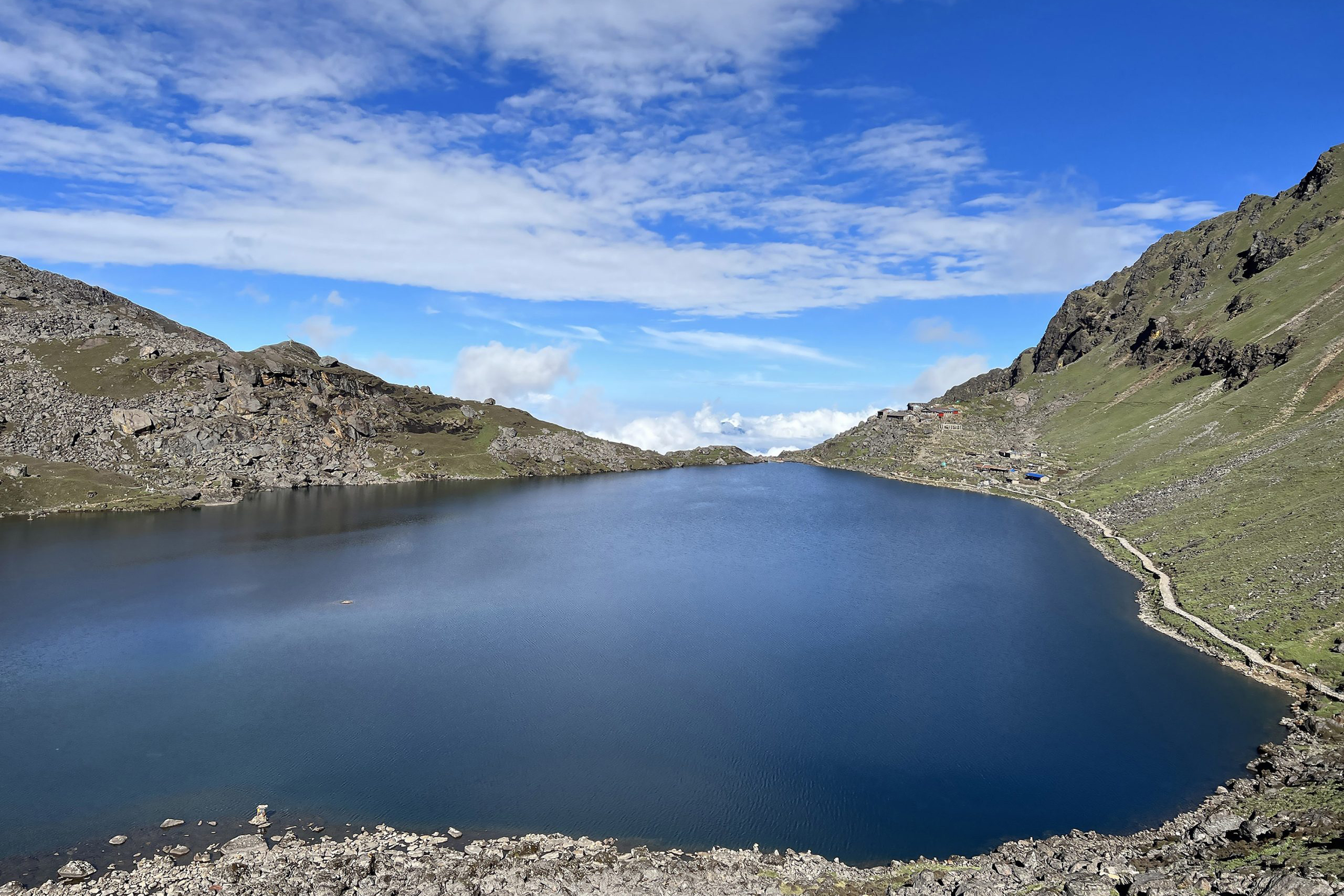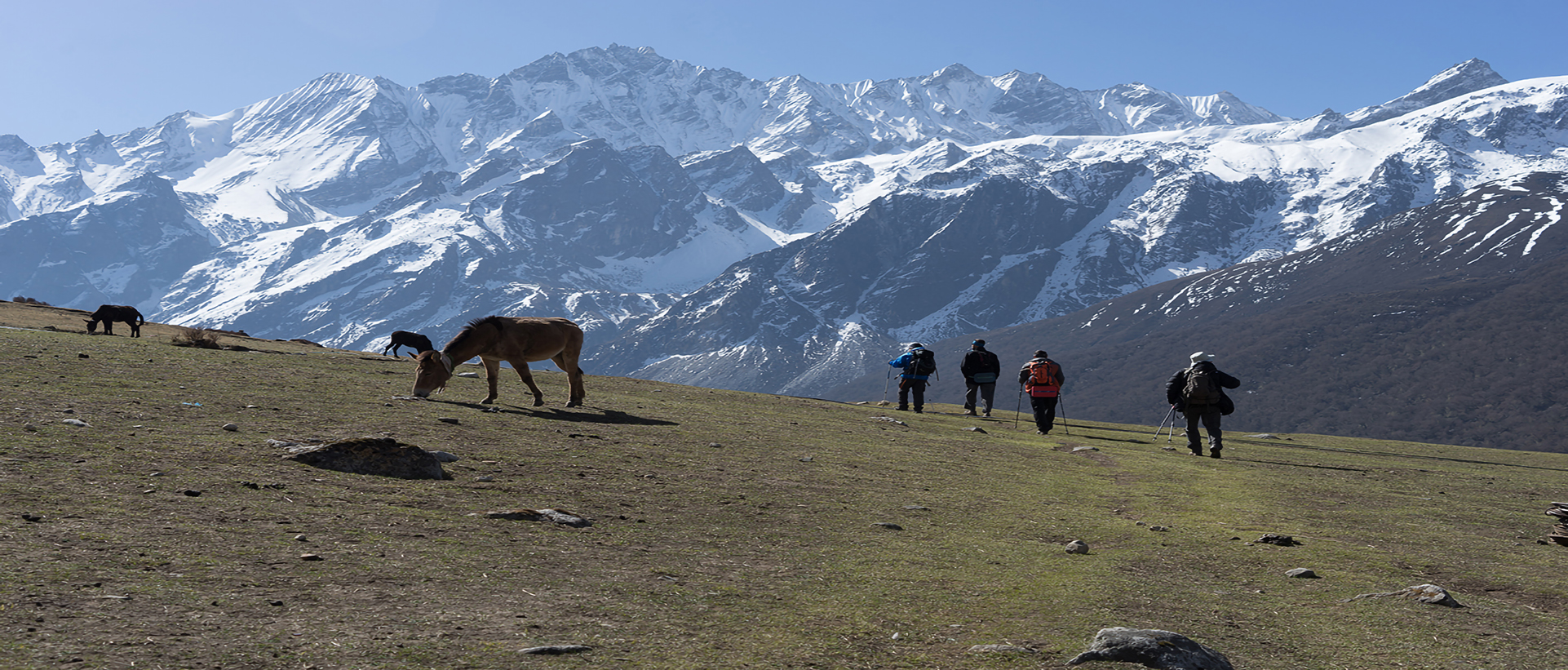
LOVELY LANGTANG -“A Vistas To Die For”
- Home /
- Nepal /
- Trekking & Hiking /
- Langtang Region /
- LOVELY LANGTANG -“A Vistas To Die For”
The Langtang Trek is to the north of the valley of Kathmandu. It is a narrow valley that lies just south of the Tibet border and is sandwiched between the main Himalayan ranges to the north and slightly lowers range of snowy peaks to the south. Langtang Lirung (7246 m) dominates the valley to the north; Gang Chhenpo (6388 m) and Naya Kangri (5846 m) lie to the south; and Dorji Lakpa (6966m) protects the east end of the valley. The area was designated Nepal’s first Himalayan National Park in 1971 and use of firewood is strictly prohibited.
This high and isolated region is inhabited by Tamangs whose religious practices, language and dress are much more similar to those of Tibet than to the traditions of their cousins in the middle hills. A visit to Langtang offers an opportunity to explore villages, to climb small peaks and to visit glaciers at a comfortably low elevation.
Legend: According to legend, a lama following a runaway Yak discovered the valley. Hence the name ‘Lang ‘ – Tibetan for Yak and ‘Teng’ (more correctly Dhang) means to follow. Yaks still live in the valley but they now share it with trekkers.
Route Map
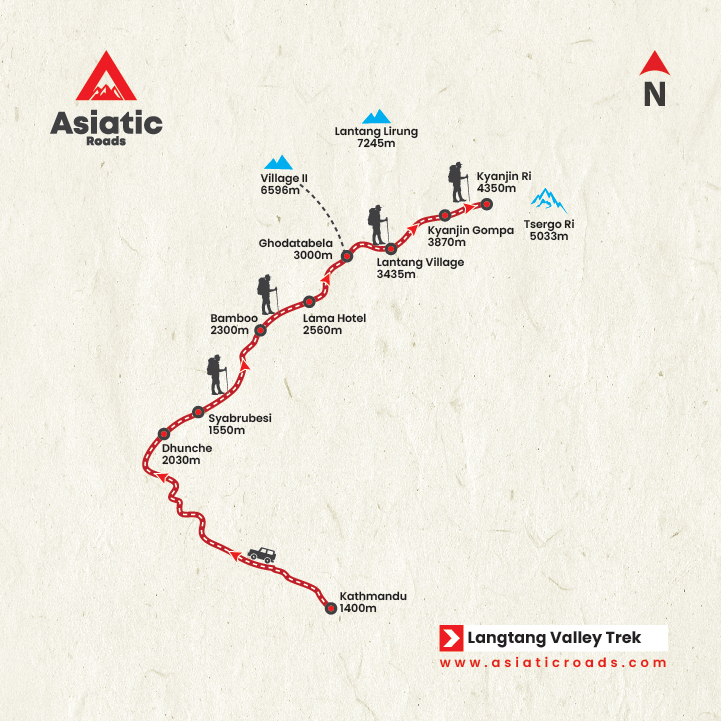
Itinerary In Detail
-
Day 01: Arrival in Kathmandu
Upon arrival in Kathmandu’s Tribhuvan International Airport, meet Asiatic Roads representative, assist and transfer to the hotel. At the hotel’s lobby welcome refreshments will be served and room check in assistance provided. Shortly afterwards there will be a trek/ tour briefing at the hotel’s lobby.
Overnight at hotel.
-
Day 02: Drive to Sybrubesi (1,460 m / 4,788 ft.) – 7 hrs.
Leave Kathmandu early for the seven-hour journey to Langtang Valley. The road climbs high over ridges as it leaves the Kathmandu Valley, and provides impressive views of the Annapurna Himalayas in the west, to Manaslu, Ganesh Himal and the peaks of the Langtang region ahead.
We drive through the bustling town of Trisuli before climbing towards Dunche and the Langtang National Park. After the town of Dunche it is another hour downhill to Syabru Besi and your lodge for the night.
Dinner and overnight at tea house lodge.
-
Day 03: Trek to Lama Hotel via Bamboo (2,410 m / 7,904 ft.) – 7/8 hrs.
Descend through the village of Syabru and continue down the ridge until you come to a trail to the east that drops sharply off the ridge and through a dense forest. Trail starts meandering through the cool deciduous forests of oak and maple that cover the lower sections of the valley and climbs through massive stands of spruce, fir and blue pine. Towering walls close in and your paths will skirt precipitous drops, which fall into a silt-laden river below. Cross a bridge (1960m) over a tributary of the Langtang Khola and then climb up from the river and in an hour, shortly after the trail levels off, you join the old Langtang trail from Syarpagaon and Syabrubensi. Another hour from this trail junction brings you to the Lama Hotel in the tiny village of Chongong.
Dinner and overnight at Tea house lodge.
-
Day 04: Trek to Langtang via Ghoretabela (3,430 m / 11,250 ft.) – 5/6 hrs.
Enter a forested area from which you occasionally catch glimpses of Langtang Lirung through gaps in the trees. It is a gentle ascent during which the elevation gradually increases. After an hours trek the trail crosses to the north bank of the river and climbs steeply for an hour up through the Langtang gorge before the ascent eases and the valley widens out into an area of fir and rhododendron. Pass the Gumnachowk which has one hotel. Climb a short steep hill from the river path and the valley widens and soon arrive at Ghoretabela (3,010m). Ghoratabela lies near the end of the main forest area where an army post is located. We shall stop for lunch.
From Ghoretabela, cut through the cultivated fields which dot the landscape and after a short while, cross a steep hill. The forested zone ends and now follow a gently sloping path amid low shrubs to emerge to grassy fields. The Village of Langtang appears with the outline of Ganchempo (6387m) behind it. Climb the gently rising grassy area and pass below a monastery to enter Langtang, a large Sherpa village, where the houses are enclosed by stone walls.
Dinner and overnight at Tea house lodge.
-
Day 05: Trek to Kyangjin Gompa (3,840 m / 12,595 ft.)- 3 hrs.
Set out through the village and after a short climb arrive at a chorten. From this point there is an amazingly long mani stone wall which is truly a memorable sight. Continue along a gently sloping path atop terraced hills and after passing two villages the valley widens and becomes U – shaped. The trail enters a level, dry riverbed and after crossing the flow from the Lirung Glacier, visible on the left side are the Kimshun (6745m) and Yansa Tsenji (6543m). Cross an old lateral moraine and arrive at Kyanjin Gompa. Out here there is a Government rest house, cheese factory and a monastery. From Kyanjin, there are 180-degree views of the mountains at eye to eye level which is simply breathtaking.
Pm: Free to explore around Kyangjin Gompa.
Dinner and overnight at Tea house lodge.
-
Day 06: Climb Kyanjin Ri (4,850 m / 15,908 ft.) – 5~6 hrs.
Today you can rest or explore the area. You can visit the monastery and the cheese factory, walk up the moraine to see the spectacular ice faces and tumbling glaciers of Langtang Lirung or ascend Kyangjin Ri directly behind the village, for a breath-taking panorama of the Langtang peaks.
Dinner and overnight at Tea house lodge.
-
Day 07: Backtack to Ghore Tabela
Since you will be acclimatized and will be descending, we will trek down all the way to Ghore Tabela through the same trail in a day’s walk from Kyanjin Gompa.
Dinner and overnight at Tea house lodge.
-
Day 08: Backtrack to Sybru Besi via Lama Hotel.
We continue to keep retracing our steps back on the same trail and you should be able to reach Syabru in another day descending.
Dinner and overnight at Tea house lodge.
-
Day 09: Drive back to Kathmandu.
After early breakfast meet waiting Land Cruiser and start drive back to Kathmandu. Upon arrival in Kathmandu check in at a hotel. The rest of the day is free for leisure.
Eve: Group Farewell Dinner.
Overnight at hotel.
-
Day 10: Final departure
Free until final departure transfer to Kathmandu’s International Airport.
9 Days From
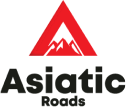
Any Question?
Feel free to call our travel experts.
+977 9851189018, +977 9801089018
info@asiaticroads.com
Whats Include and Exclude
Services Inclued
- Two nights stay at hotel in Kathmadnu on twin / double room sharing basis, inclusive of breakfast and taxes.
- All transfers, drives, in a private car van as per itinerary accompanied by a Professional English speaking guide/ representative from Asiatic Roads.
- Drive from Kathmnadu – Bharkhu (pre trek) & Syabrubesi to Kathmandu (post trek) accompanied by English speaking Sherpa guide in a 4 W/D Land Cruiser.
- All inclusive 07 nights / 8 days Langtang “Blue Poppy” Trek inclusive of all meals (breakfast, lunch, tea, snacks and dinner), accommodation at nice tourist class Tea house lodges.
- Langtang National Park Permit Fee.
- Services of trained, trusted and highly experienced trekking Guides and Sherpa camp helpers including and a team of strong and reliable porters.
- Sherpa team and equipment destination charges.
Services not Inclued
- International airfares
- Nepal entry visa fees (Not applicable for Indian citizens)
- Meals except lunch and dinner while staying at hotel in Kathmandu.
- Items of a personal nature such as; bar bills as alcoholic and aerated beverages, laundry, telephone / mobile calls, extra mileage, personal gratuities as tips to guides, drivers and porters etc.
- Anything’s that are not mentioned in above cost includes section.
Accomodations
Accomodation (Hotels envisaged or similar)
| Kathmandu | Hotel | 1 | FB |
|---|---|---|---|
| Sybrubeso | Tea House | 1 | BB |
| Lama Hotel | Tea House | 1 | BB |
| Ghoretabela | Tea House | 1 | BB |
| Kyanging Goumpa | Tea House | 1 | BB |
| Kyanjing Ri | Tea House | 2 | BB |
| Ghore Tabela | Tea House | 1 | BB |
| Lama Hotel | Tea House | 1 | BB |
| Kathmandu | Tea House | 1 | BB |
9 Days From

Any Question?
Feel free to call our travel experts.
+977 9851189018, +977 9801089018
info@asiaticroads.com
Additional Information
-
Clothing & Equipments
WHAT TO WEAR:
Light clothing is only for short treks up to seven days at altitudes up to 6000ft (1830m) during fall (autumn) from September to November and in spring between March to May. The other months at all altitudes will be cold and at most times the temperatures will be below zero.
Footwear:
You will need hiking boots with ankle support, sneakers for flat trails, and flip-flops or chappals for use around the camp/lodge.
Clothes:
Shirts, T-shirts (4), blouse, etc., for daywear and a woolen shirt/T-shirts for evenings.
MEN:
Shorts, cotton trousers, jeans, sweatpants (recon-mended), etc.
Undergarments & Socks:
Thermal underwear and inner trousers for the above 7,000 ft. treks. Thick trek socks.
Warm Clothes:
A light sweater, a windcheater or light lined/padded jacket, and a down jacket or parka for above 7000 ft. treks. Woolen thick cap and warm gloves.
Sun / Rain:
Rain gear or umbrella and a sun hat are essential. Global warming has led to freak weather conditions and it has become more and more difficult to predict weather conditions.
Note: Umbrellas are cheap and easily available in Kathmandu.
HOW TO PACK
In The Day Pack: In the Duffel Bag: Sunglasses Towels Moisturizing/Sunscreen lotion Spare batteries Prescribed medicines Toiletries Flashlight washing soap Camera and spare film Spare clothes all wrapped in plastic bags Binoculars-optional Reading Reference book/Notebook Pencil/Pen / Water bottles/ Trek permits Toilet paper Umbrella/rain gear / Sweater Note: Sleeping bags can be purchased in Kathmandu. It is even available on hire upon request. However, we request our clients to bring their own sleeping bags because of hygiene.
-
How To Train For Trekking
Many people worry that they are not fit enough for long treks, especially in the challenging Himalayan region. However with the right training realistic expectations, and healthy on-trail habits, Himalayan treks is possible for most of healthy hikers. Here are some tips for how to train for trekking in the Himalayas.
START EARLY
You will need to build muscle, endurance and your cardiovascular system. Do no put of training until a month before you leave. It is worth splurging a bit and hiring a trainer who can design a program specifically for what you are doing. If he or she can see you’re hiking Itinerary, even better. They will likely develop a plan that spans several months. Stick with it.
USE A COMBINATION OF EXERCISES
If you choose to develop you own plan (after careful research), use a variety of exercises. Including trail running ensures you will be confident on your feet on uneven terrain. You will also want to include box steps on boxes of varying heights while holding weights. Though you need to build strength to hike 4 to 9 or 10 hours in a day, it is also worthwhile to include sprint intervals, either running or on a bike. This improves your recovery time. Try short bursts of pushing a heavy sled to build your CV system to ensure you don’t feel like throwing up on the trail!! And do not forget your Arms! You should use your trekking poles, and these may give you more of a forearm workout tan you anticipate. Try some triceps extensions, as well as pull ups, rows and dips for your shoulders and back. You will, after all, be carrying a day pack.
STAYING HEALTHY ON TREK
Water is most important part of your hike. Drink at least 3/4 liters of water a day. Ensure yourself you are rehydrating all the time (Dehydration is one of the reason of Acute Mountain Sickness) . Stretch your calves, hips and gluteus any time you stop. This will minimize morning soreness and prevent injury. Bring bio freeze, icy hot, or Tiger Balm for rubbing on sore muscles at night (Tiger Balm is easily available in Kathmandu & Pokhara); these are practically helpful on and behind my knees after steep down hills. No matter what your diet is at your home, eat on a trail. All the teahouses serve pasta, rice, and pizza. Take an advantage of all those carbs. Avoid having alcoholic liquor especially while going up in the High Altitude.
WHEN YOU FINISH
The work you have done hiking will affect you even particularly painful, as your legs may be very restless for several days. Wear compression socks and try to get an aisle seat so you can walk around. After all this, you will definitely come away with a sense of exactly how strong your body is.
-
Nepal Visa Information
Updating Soon!!!!
-
Notes On Acute Mountain Sickness
Key to acclimatization: Is adequate hydration, adequate nutrition & managing personal comfort through adequate layers lead to acclimatization.
Following extracts are taken from “The Wilderness First Responder” by Buck Tilton, director of Wilderness Medicine Institute of NOLS, USA
Dehydration
Without water there would be no life – at least no life, as you know it…
Water puddles inside every one of your cells, and flows through the microscopic spaces between cells. In water, oxygen and nutrients float to all parts of your body, and waste products are carried away. When your kidneys remove waste from your body those wastes have to be dissolved in water. Digestion and metabolism are water-based processes, and water is the primary lubricating element in your joints. You even need water to breathe, your lungs requiring moisture to expedite the transfer of oxygen into blood and carbon dioxide out of blood. Sweat, as mentioned, is mostly water. The water in your blood carries heat from warmer body parts to cooler areas of your anatomy when you are exposed to cold. In short, if aren’t well hydrated, you won’t be able to stay healthy, maximize your performance, or even maintain joy at being outdoors.
The water in your body, the fluid that keeps you alive and active, leaves you at an alarming rate. Estimates vary widely, but an average person at rest on a normal day loses between two and three liters of water. One to one-and-a-half liters rushes out as urine, and another one-tenth liter in defecation. Moisture is lost from act of breathing, more than half a liter per day, and that rate increases in dry winter air.
Then there’s sweat. The fluid lost in perspiration can climb to one to two liters per hour during periods of strenuous exercise. Compared to watching TV all day, one hour of exercise may demand approximately a 50 percent increase in the amount of water your body uses.
Your thirst mechanism that feeling of ”Gosh, I need a drink of water”, doesn’t kick in until you’re about one to one-and-a-half liters low. Down three to four liters can leave your endurance decreased to 50 percent and your oxygen uptake reduced close to 25 percent…
Acclimatization
The medical problems collectively referred to, as “altitude illnesses” is the result of hypoxia, insufficient oxygen in the blood for normal tissue function, a result of the decreased barometric pressure at higher altitudes. When you go up, the barometric pressure goes down, the concentration of oxygen in the air decreases, and the chance of altitude illness climbs.
Since there is a measurable increase in ventilation and decrease in aerobic exercise performance above 4,000 feet elevation, “high altitude” can be said to start at that point. Complications seldom occur, however, below 8,000 feet. In defining terms, consider 8,000 to 12,000 feet as high altitude, 12,000 to 18,000 as very high altitude, and 18,000 plus as extreme high altitude.
The human body will adjust to dramatic changes in barometric pressure, given enough time. Altitude illnesses – which range from mildly disturbing to completely fatal – are determined, primarily, by three factors:
How high the patient goes.
- How fast the patient attains a specific altitude, and
- Predisposing factors such as genetics and previous upper respiratory illnesses.
- Critical to acclimatization is adequate hydration and nutrition.
PREVENTION:
As mentioned earlier, most people will adjust to altitude given enough time. Staged ascent is the key to acclimatization and, therefore, the key to preventing altitude illnesses.
Adequate hydration is critical to the prevention of altitude illnesses. You should drink enough water to keep your urine output clear and copious.
A high calorie diet is essential for the energy needed to ascend and acclimatize.
Avoid respiratory depressants, such as sleeping pills and alcohol.
…But physical fitness prior to ascent is a bonus in the game of safety and enjoyment. Fitness does not, however, protect against acute mountain sickness.
(Friends: this is just to inform you about these important factors that we would be dealing in on the mountain. I know that there would be a lot of questions in your mind – how does one acclimatize, what food is to be taken, what are the early signs and symptoms that would alert me to start taking extra efforts to stay hydrated/acclimatized, etc. etc.)
-
Notes For Trekkers / Travellers
Dear Guests,
Namaste & warm Greetings from Nepal!!We are very pleased that you have inquired for your trek with Asiatic Roads. The idea of this hand out is to furnish you with information for your pre-trek preparations.
Firstly, we recommend that you travel light. A good-sized duffel bag with a top length zipper that can lock is best, together with a day pack for carrying personal items on the trek. An extra smaller bag would be handy to carry back your souvenirs after the trip.
AFTER ARRIVAL IN KATHMANDU
1. TREK BRIEFING:
On your arrival in Kathmandu, we will arrange to meet for a pre-trek briefing. Full information on all aspects of your trek, questions and doubts will be discussed. On trek your Sherpa leader (sardar) will give you more details about the route, villages, people and other information regarding the trek.2. PACKING:
You may leave behind part of your luggage in your hotel or our locker room before the trek, in Kathmandu. All baggage is to be clearly marked and locked. Kindly refrain from carrying or wearing valuables on the trek. You may leave them behind at the safety deposit box at your hotel or with us.3. HOW TO PACK:
Your clothes and equipment should fall into the following 4 categories:1. What you are going to leave behind in Kathmandu.
2. What you are going to wear on the trail.
3. What you are going to carry in your day pack.
4. What you would like the porters to carry for you.Excess clothes and luggage can be stored in your hotel’s storeroom, and valuables in the safety deposit box. Please label your luggage and make sure to take a receipt from the front desk of your hotel for all the things you would like to leave behind while you are away.
ON TREK
1. YOUR STAFF ON THE TRIP:
Will consist of one English speaking Sirdar (Guide) and Assistance Guide or Escort who will be wholly responsible for the execution of the trip once it hits the trail. He will be assisted by Sherpa(s) as necessary.2. WHAT TO CARRY DURING THE TREK:
Your daypack, preferably waterproof should be light, small and comfortable. All small personal items like toilet paper, water bottle, medicines, extra shirt, light warm wears, rain gear, gloves etc. that may be needed for the days trek should be packed. Your duffel will be carried by porters who may not be with you at all times.3. MONEY ON TREK:
You may want to buy drinks at wayside shops and souvenirs from the natives. Small change should be carried. As customary, we can help discuss in detail in the pre-trek briefing.TREK KIT LIST
WHAT TO WEAR:
Light clothing are only for short treks up to seven days at altitudes up to 6000ft (1830m) during fall (autumn) from September to November and in spring between March to May. The other months at all altitudes will be cold and at most times the temperatures will be below zero.Footwear:
You will need hiking boots with ankle support, sneakers for flat trails and flip-flops or chappals for use around the camp/lodge.Clothes:
Shirts, T-shirts (4), blouse, etc., for daywear and a woolen shirt/T-shirts for evenings.MEN: Shorts, cotton trousers, jeans, sweat pant (recon-mended) etc.
Undergarments & Socks:
Thermal underwear and inner trouser for the above 7,000 ft. treks. Thick trek socks.Warm Clothes:
A light sweater, a windcheater or light lined/padded jacket and down jacket or parka for above 7000 ft. treks. Woolen thick cap and warm gloves.Sun / Rain:
Rain gear or umbrella and a sun hat is essential. Global warming has led to freak weather conditions and it has become more and more difficult to predict weather conditions.
Note: Umbrellas are cheap and easily available in Kathmandu.HOW TO PACK
In The Day Pack: In the Duffel Bag:
Sun glasses Towels
Moisturizing/Sun screen lotion Spare batteries
Prescribed medicines Toiletries
Flash light washing soap
Camera and spare film Spare clothes all wrapped in plastic bags
Binoculars-optional
Reading Reference book/Note book
Pencil/Pen / Water bottles/ Trek permits
Toilet paper
Umbrella/rain gear / SweaterNote: Sleeping bags can be purchased in Kathmandu. It is even available on hire upon request. However, we request our clients to bring their own sleeping bags because of hygiene.
ADDITIONAL ITEMS:
For most treks from mid-November till mid-February and for those above 10,000 ft. /3000 m., in Spring and Autumn, anti-dazzle glasses or goggles with side attachments are recommended and High altitude food supplements (favorite snacks) if necessary.IMPORTANT NOTE:
In the event of an accident or serious ailment on a trek, helicopter evacuation can be arranged. The helicopter fare with 10% service charge and the hospital/medical charge will have to be cleared before departing from Kathmandu. A risk, release and guarantee form has to be signed before leaving on a trek with us.INSURANCE:
There are no reliable medical insurance policies in Nepal for foreigners. We strongly recommend you to take comprehensive holiday insurance in your own country covering adventures involving some elements of risk, especially to cover Emergency Helicopter Evacuation.BOOKS:
Trekking in the Nepal Himalayas by Stan Armington published by the Lonely Planets books provides you comprehensive information on all matters regarding trekking in Nepal
The Trekkers Peaks of Nepal by Bill O’Connor published by Crow Wood press in U.K. provides you with information on all matters regarding climbing peaks in Nepal.
Trekking in Nepal by Toru Nakano published by Allied Publishers gives you some insight into some important trekking areas in Nepal. A map of Nepal is enclosed in the book.
9 Days From

Any Question?
Feel free to call our travel experts.
+977 9851189018, +977 9801089018
info@asiaticroads.com
Reviews
In my 2 week stay, John was very professional and took me around to experience all that Kathmandu and surrounding areas has to offer. Sites were seen and many locals were met through John’s network.

Steven Stone
TravellerIn my 2 week stay, John was very professional and took me around to experience all that Kathmandu and surrounding areas has to offer. Sites were seen and many locals were met through John’s network.

Steven Stone
Traveller9 Days From

